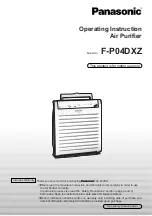
31
UNICO-HE
HO
UR
ON
OFF
C
SE
T
AUT
1H
OU
R
A
AUT
AUT
1HR
ON/O
FF
TEM
P
HIG
H P
OW
ER
HO
UR
ON
OFF
C
SE
T
AUT
1H
OU
R
A
AUT
AUT
1HR
ON/
OFF
TEM
P
HIG
H P
OW
ER
Fig. 3
Fig. 4
As far as possible, in any case, it is important to try and
reduce major thermal loads by the following means:
Large glass panes exposed to sunlight should be provided
with curtains on the inside or shades on the outside
(Venetian blinds, verandas, refracting films, etc.)
The air-conditioned room should be closed as much of
the time as possible.
Halogen spotlights or other electrical equipment with high
power consumption should not be used in the room
(toasters, steam irons, hot plates for cooking, etc.).
- It should not be installed in a position where the air flow
can strike the people underneath directly (fig. 2).
- It should not be directly over another appliance (television
set, radio, refrigerator, etc.), or over a source of heat
(fig. 3).
- There should be no obstacles for reception of signals
emitted by the remote control (fig. 4).
This operation should be carried out using the proper tools
to facilitate your work and prevent excess damage or
disturbance to your client.
The best tools for drilling large holes in walls are special
drills called core borers with very high twisting torque and
adjustable rotation speed depending on the diameter of
the hole to be drilled.
To prevent the creation of large amounts of dust and rubble
due to drilling, the core borer can be fitted with a vacuum
system applied by means of suction cups to the drilling
zone.
Our Service Department can give you all necessary
information to enable you to find these devices.
To drill the holes, proceed as follows:
Fasten the drilling template to the wall leaving the
necessary space from the ceiling, floor and side walls as
shown on the template. Use adhesive tape to fasten it in
place.
Use a small drill or punch to mark, with extreme care, the
exact centre of each of the holes to be drilled.
Using a core boring head measuring at least 154 mm to
drill the two holes for entry and exit of the air.
Note: The holes should have a slight outward
inclination to prevent any backflow of water from the
pipes (see fig.1).
Most of the removed material is expelled outwards,
therefore make sure that it does not hit any person or
object when it falls out.
In order to avoid as much as possible outer plaster
breaking, it is necessary to proceed carefully with the
last part of hole execution, decreasing pressure on core
borers.
INSTALLATION OF THE UNIT
CHAP. 2.3
2.3.1
Drilling the wall
Fig. 5
Summary of Contents for UNICO 11 HE
Page 49: ......








































